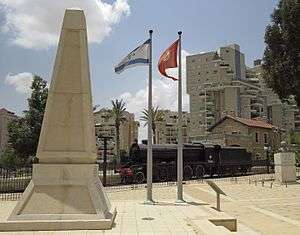Beersheba Turkish Railway Station
- For other stations in Be'er Sheva, see Be'er Sheva North and Be'er Sheva Central.
Beersheba Turkish Railway Station תחנת הרכבת הטורקית בבאר שבע | |
|---|---|
 The station photographed in 2015 | |
| Location | Ali Daivis Street, Beersheba |
| Coordinates | 31°14′43″N 34°47′06″E / 31.245370°N 34.784879°ECoordinates: 31°14′43″N 34°47′06″E / 31.245370°N 34.784879°E |
| Line(s) | Railway to Beersheba |
| History | |
| Opened | 1915 |
| Closed | 1927 |
The Beersheba Turkish Railway Station (Hebrew: תחנת הרכבת הטורקית בבאר שבע, Turkish: Beerşeba Türk Demiryolu İstasyonu) is a historic railway station in the city of Beersheba, Israel, located west of the Old City.
History
The station was opened in October 1915 during the Ottoman rule in Palestine and the Sinai and Palestine military campaign of World War I. The main Turkish objective in the Middle East during WWI was to either capture or disable the Suez Canal, which would have put the British Empire at a great disadvantage. However, transporting troops and supplies from Constantinople to the front lines took months by camel caravan.[1]
After his ill-fated assault on the British garrison along the canal in January–February, 1915, Jamal Pasha enlisted the help of the German engineer Heinrich August Meissner, who also planned the Hejaz Railway, to help him find a more efficient method of logistics. Meissner started constructing a railway to the south of the Palestine region, with the Wadi Surar (Nahal Sorek) station serving as the starting point. Two railways were originally built: one to Beit Hanoun, and the other to Beersheba. The two lines were collectively called the 'Egyptian Branch'.[1]
The Railway to Beersheba opened for traffic just 9 months from the start of construction. The rest of the planned Egyptian branch was never completed, although Meissner managed to continue the line from Beersheba further south to Kusseima in the Sinai Peninsula.[1]
The station complex included: a station building, similar in style and design as other Ottoman railway stations in Palestine, a water tower, an accommodation building for the Station master and a maintenance depot. The railway to Be'er Sheva enabled the Ottomans to quickly resupply their forces in the area, and made the station a major military center during the war.
In October 1917, after the Stalemate in Southern Palestine from April to October 1917, the British forces led by General Edmund Allenby captured Beersheba defended by the III Corps (which had fought at Gallipoli). The British connected the Railway to Beersheba to the coastal line in Qantara near Rafah by 3 May 1918, and the old connection to the north through Wadi Surar was discarded because it was not standard gauge. In July 1927, the line between Beersheba and Qantara was also discontinued and the station was closed, citing low usage and high maintenance costs.[2]
Following Israeli independence, Israel Railways reconstructed the railway to Beersheba in standard gauge along an improved route. However, this railway did not reach the old Turkish station. Instead, a new station, Be'er Sheva North, was openened in the northeastern part of town in 1956, with the new railway extending from it then skirting Beersheba from the east and continuing towards Dimona. In 2000 Israel Railways built a spur from the railway heading to Dimona to a new passenger terminal in Beersheba named Be'er Sheva Center Railway Station. This station is located approximately 1250 meters east of the old Turkish station.
The station today
Rail heritage museum
In 2013 the station complex and buildings were renovated and opened as small rail heritage museum.
The site's key exhibit is a TCDD 45151 Class steam locomotive, which was acquired by the municipality of Beersheba in December 2012 and cosmetically restored.[3] Many examples of this type (Class 8F of British origin) were operated by Israel Railways in its early years. One of those, number 70414, was featured in a popular Hebrew song and a short film of the 1950s performed by Arik Lavie and written and directed by Haim Hefer about the last steam locomotive of Israel Railways, telling the story of its final journey from Beersheba to Israel Railways' workshops in Haifa Bay to be scrapped. This ballad is titled "The Locomotive Song" (שיר הקטר) and begins with the words "In the train station in Beersheba stood a locomotive, whose number was 70414...". In recognition of the famous song the locomotive on display is also numbered 70414.
Turkish soldiers' monument
In October 2002, a monument to honor the 298 Turkish soldiers that lost their life during the Battle of Beersheba in 1917 was erected east of the station in cooperation between the Be'er Sheva Municipality and Turkish authorities.
A commemorative plaque was placed at the base of the monument. This plaque was previously located nearby at the Beer Sheva War Cemetery for British and ANZAC soldiers who died in the same battle.
See also
References
- 1 2 3 Cotterell, Paul (1984). "Chapter 3". The Railways of Palestine and Israel. Abingdon, UK: Tourret Publishing. pp. 14–31. ISBN 0-905878-04-3.
- ↑ Cotterell, Paul. "The Land of Israel between World Wars". Make Straight the Way (in Hebrew). p. 56.
- ↑ Stanier 8F sold to museum in Israel, Robin Jones, Heritage Railway, Dec 6th, 2012
| Wikimedia Commons has media related to Turkish railway station in Beersheba. |